英语教学法实践课总结
- 格式:doc
- 大小:590.00 KB
- 文档页数:2
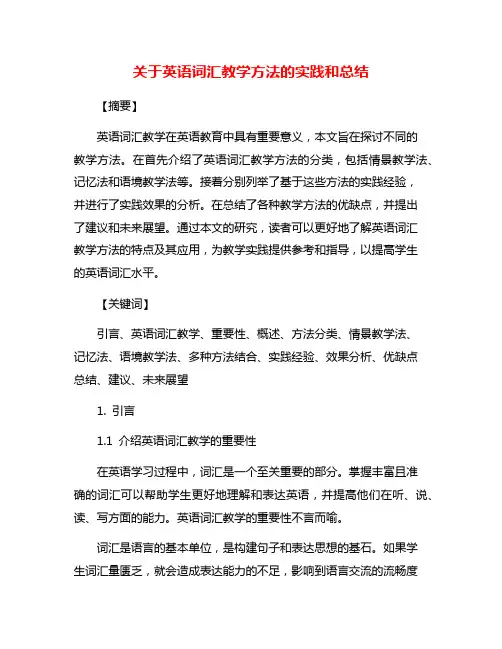
关于英语词汇教学方法的实践和总结【摘要】英语词汇教学在英语教育中具有重要意义,本文旨在探讨不同的教学方法。
在首先介绍了英语词汇教学方法的分类,包括情景教学法、记忆法和语境教学法等。
接着分别列举了基于这些方法的实践经验,并进行了实践效果的分析。
在总结了各种教学方法的优缺点,并提出了建议和未来展望。
通过本文的研究,读者可以更好地了解英语词汇教学方法的特点及其应用,为教学实践提供参考和指导,以提高学生的英语词汇水平。
【关键词】引言、英语词汇教学、重要性、概述、方法分类、情景教学法、记忆法、语境教学法、多种方法结合、实践经验、效果分析、优缺点总结、建议、未来展望1. 引言1.1 介绍英语词汇教学的重要性在英语学习过程中,词汇是一个至关重要的部分。
掌握丰富且准确的词汇可以帮助学生更好地理解和表达英语,并提高他们在听、说、读、写方面的能力。
英语词汇教学的重要性不言而喻。
词汇是语言的基本单位,是构建句子和表达思想的基石。
如果学生词汇量匮乏,就会造成表达能力的不足,影响到语言交流的流畅度和准确性。
词汇也是语言学习的重要桥梁,通过学习词汇,学生可以更深入地理解英文文本,培养阅读和写作的能力。
词汇还是扩展语言知识面的关键,通过学习词汇,学生可以了解更多的文化背景和社会常识。
英语词汇教学的重要性在于它直接关系到学生的语言水平和交流能力。
只有通过科学有效的教学方法,才能帮助学生真正掌握词汇,进而提升整体语言能力。
本文将对不同的英语词汇教学方法进行探讨,并总结其优缺点,为今后的教学实践提供借鉴和参考。
1.2 概述本文内容本文将介绍关于英语词汇教学方法的实践和总结。
在学习英语过程中,词汇是基础,也是重要的部分。
通过不同的教学方法,可以帮助学生更好地掌握词汇,并提高他们的语言能力。
本文将从分类英语词汇教学方法开始,包括基于情景教学法、记忆法和语境教学法等不同方法的实践经验。
通过对这些实践经验的总结和分析,可以更好地了解各种方法的优势和不足,以及多种方法结合的实践效果。

英语教育实习总结1200字5篇篇1时光荏苒,转眼间,我在某中学的英语教育实习已经圆满结束。
这段时间里,我不仅积累了丰富的教育经验,还与学生们建立了深厚的友谊。
在此,我谨向实习学校及全体师生表示衷心的感谢。
一、实习背景与目标本次实习旨在通过亲身实践,提高我的英语教育水平,并让我对英语教育事业充满热情。
在实习过程中,我计划重点提高自己的英语教学能力,同时培养团队协作精神和创新精神。
二、实习内容与方法1. 课堂实践在实习期间,我积极参与课堂实践,通过讲解、互动和评估等多种方式,不断锻炼自己的英语教育能力。
我注重引导学生积极参与课堂讨论,提高他们的英语听说读写能力。
同时,我还结合课本内容,设计了一系列有趣的活动和游戏,让学生在轻松愉快的氛围中学习英语。
2. 课外辅导除了课堂实践外,我还利用课余时间,为学生提供课外辅导。
在辅导过程中,我针对学生的个体差异,量身定制辅导方案,帮助学生解决学习难题。
此外,我还鼓励学生多读英文书籍、看英文电影等,以提高他们的英语语感和表达能力。
3. 团队活动在实习过程中,我积极参与学校组织的各种团队活动,如集体备课、教学研讨等。
这些活动不仅锻炼了我的团队协作能力,还让我有机会向其他优秀教师学习,汲取他们的宝贵经验。
三、实习成果与收获通过本次实习,我不仅提高了自己的英语教育水平,还收获了许多宝贵的经验。
首先,我学会了如何将理论知识与实践相结合,运用所学知识解决实际问题。
其次,我培养了团队协作精神和创新精神,学会了与他人共同合作完成任务。
此外,我还深刻认识到教育的重要性,决心为英语教育事业贡献自己的力量。
四、反思与建议虽然本次实习取得了圆满成功,但我也意识到自己在某些方面仍有待提高。
首先,在课堂教学方面,我需要进一步丰富教学方法和手段,提高课堂的趣味性和互动性。
其次,在课外辅导方面,我需要更加注重学生的个体差异,做到因材施教。
最后,在团队活动方面,我需要更加积极地参与讨论和交流,汲取更多优秀教师的经验。
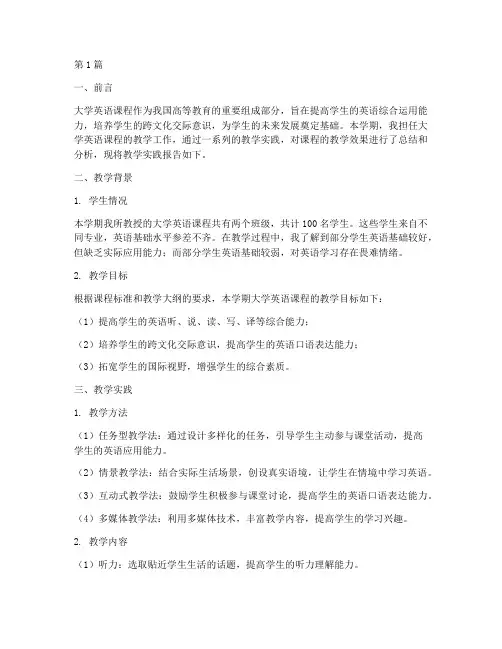
第1篇一、前言大学英语课程作为我国高等教育的重要组成部分,旨在提高学生的英语综合运用能力,培养学生的跨文化交际意识,为学生的未来发展奠定基础。
本学期,我担任大学英语课程的教学工作,通过一系列的教学实践,对课程的教学效果进行了总结和分析,现将教学实践报告如下。
二、教学背景1. 学生情况本学期我所教授的大学英语课程共有两个班级,共计100名学生。
这些学生来自不同专业,英语基础水平参差不齐。
在教学过程中,我了解到部分学生英语基础较好,但缺乏实际应用能力;而部分学生英语基础较弱,对英语学习存在畏难情绪。
2. 教学目标根据课程标准和教学大纲的要求,本学期大学英语课程的教学目标如下:(1)提高学生的英语听、说、读、写、译等综合能力;(2)培养学生的跨文化交际意识,提高学生的英语口语表达能力;(3)拓宽学生的国际视野,增强学生的综合素质。
三、教学实践1. 教学方法(1)任务型教学法:通过设计多样化的任务,引导学生主动参与课堂活动,提高学生的英语应用能力。
(2)情景教学法:结合实际生活场景,创设真实语境,让学生在情境中学习英语。
(3)互动式教学法:鼓励学生积极参与课堂讨论,提高学生的英语口语表达能力。
(4)多媒体教学法:利用多媒体技术,丰富教学内容,提高学生的学习兴趣。
2. 教学内容(1)听力:选取贴近学生生活的话题,提高学生的听力理解能力。
(2)口语:围绕话题进行口语练习,提高学生的口语表达能力。
(3)阅读:精选不同题材的阅读材料,提高学生的阅读理解能力。
(4)写作:指导学生进行写作训练,提高学生的写作能力。
3. 教学过程(1)课前准备:根据教学内容,设计教学活动,准备教学资料。
(2)课堂实施:通过多种教学方法,引导学生积极参与课堂活动,提高学生的英语综合能力。
(3)课后辅导:针对学生的学习情况,进行个别辅导,帮助学生解决学习中的问题。
四、教学效果1. 学生英语综合能力得到提高:通过本学期的教学,学生的英语听、说、读、写、译等综合能力得到了显著提高。
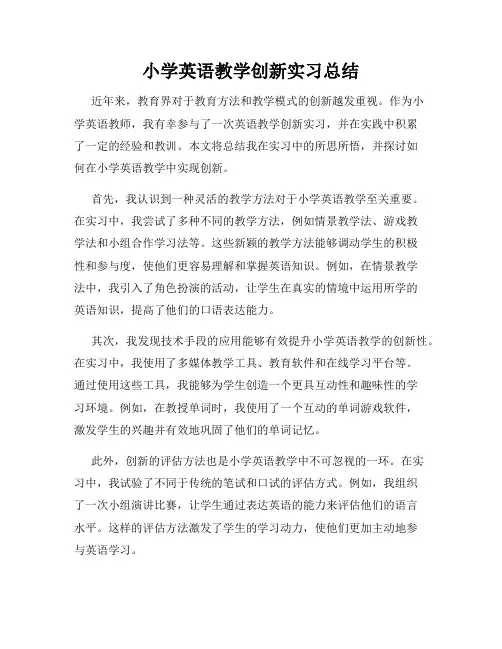
小学英语教学创新实习总结近年来,教育界对于教育方法和教学模式的创新越发重视。
作为小学英语教师,我有幸参与了一次英语教学创新实习,并在实践中积累了一定的经验和教训。
本文将总结我在实习中的所思所悟,并探讨如何在小学英语教学中实现创新。
首先,我认识到一种灵活的教学方法对于小学英语教学至关重要。
在实习中,我尝试了多种不同的教学方法,例如情景教学法、游戏教学法和小组合作学习法等。
这些新颖的教学方法能够调动学生的积极性和参与度,使他们更容易理解和掌握英语知识。
例如,在情景教学法中,我引入了角色扮演的活动,让学生在真实的情境中运用所学的英语知识,提高了他们的口语表达能力。
其次,我发现技术手段的应用能够有效提升小学英语教学的创新性。
在实习中,我使用了多媒体教学工具、教育软件和在线学习平台等。
通过使用这些工具,我能够为学生创造一个更具互动性和趣味性的学习环境。
例如,在教授单词时,我使用了一个互动的单词游戏软件,激发学生的兴趣并有效地巩固了他们的单词记忆。
此外,创新的评估方法也是小学英语教学中不可忽视的一环。
在实习中,我试验了不同于传统的笔试和口试的评估方式。
例如,我组织了一次小组演讲比赛,让学生通过表达英语的能力来评估他们的语言水平。
这样的评估方法激发了学生的学习动力,使他们更加主动地参与英语学习。
另外,与家长的密切配合也是推进小学英语教学创新的关键。
在实习中,我积极与家长沟通,了解他们对于孩子学习的期望,并与他们分享我在教学中的创新实践。
这种与家长的紧密合作为学生的学习提供了更多的支持和资源,并增强了他们在家庭环境中使用英语的机会。
然而,在实习中也暴露出了一些问题和挑战。
首先,由于时间和课程的限制,教学创新实践的内容和效果有限。
因此,在设计教学创新实践时,需要充分考虑到时间和资源的局限性,确保教学内容的创新与学科知识的传授相结合。
其次,教师对于创新教学方法的掌握和运用也存在一定的挑战。
在实践中,我遇到了一些技术操作上的困难,这需要我们不断学习和提升自身的教学能力。
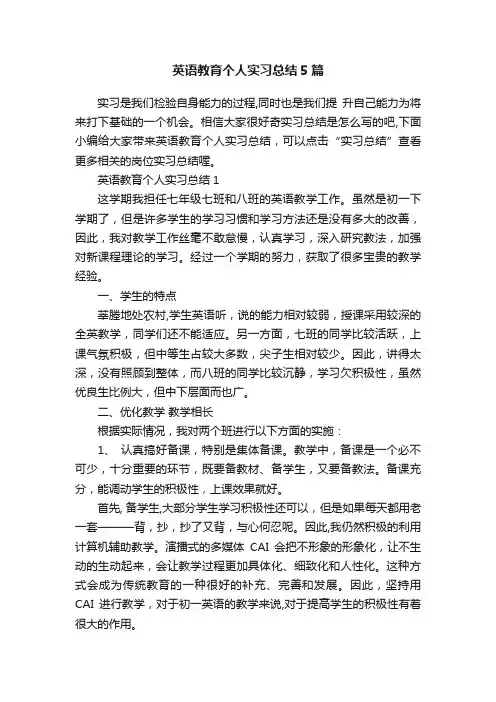
英语教育个人实习总结5篇实习是我们检验自身能力的过程,同时也是我们提升自己能力为将来打下基础的一个机会。
相信大家很好奇实习总结是怎么写的吧,下面小编给大家带来英语教育个人实习总结,可以点击“实习总结”查看更多相关的岗位实习总结喔。
英语教育个人实习总结1这学期我担任七年级七班和八班的英语教学工作。
虽然是初一下学期了,但是许多学生的学习习惯和学习方法还是没有多大的改善,因此,我对教学工作丝毫不敢怠慢,认真学习,深入研究教法,加强对新课程理论的学习。
经过一个学期的努力,获取了很多宝贵的教学经验。
一、学生的特点莘塍地处农村,学生英语听,说的能力相对较弱,授课采用较深的全英教学,同学们还不能适应。
另一方面,七班的同学比较活跃,上课气氛积极,但中等生占较大多数,尖子生相对较少。
因此,讲得太深,没有照顾到整体,而八班的同学比较沉静,学习欠积极性,虽然优良生比例大,但中下层面而也广。
二、优化教学教学相长根据实际情况,我对两个班进行以下方面的实施:1、认真搞好备课,特别是集体备课。
教学中,备课是一个必不可少,十分重要的环节,既要备教材、备学生,又要备教法。
备课充分,能调动学生的积极性,上课效果就好。
首先, 备学生,大部分学生学习积极性还可以,但是如果每天都用老一套———背,抄,抄了又背,与心何忍呢。
因此,我仍然积极的利用计算机辅助教学。
演播式的多媒体CAI会把不形象的形象化,让不生动的生动起来,会让教学过程更加具体化、细致化和人性化。
这种方式会成为传统教育的一种很好的补充、完善和发展。
因此,坚持用CAI进行教学,对于初一英语的教学来说,对于提高学生的积极性有着很大的作用。
其次, 备教材, 备教法,本学期,在新课引入时,我用了很多的心思、如,运用简笔画、幻灯、图法及其它方法向学生介绍相关信息,提供几个线索性的问题,帮助学生激起学习的兴趣。
对语言知识,语法做由浅入深的稍作处理,并设计一些别具一格的练习。
同时以各种各样的主题“任务”驱动教学,有意识地开展信息技术与现在流行的英语学科“任务型”教学相联系的横向综合教学。
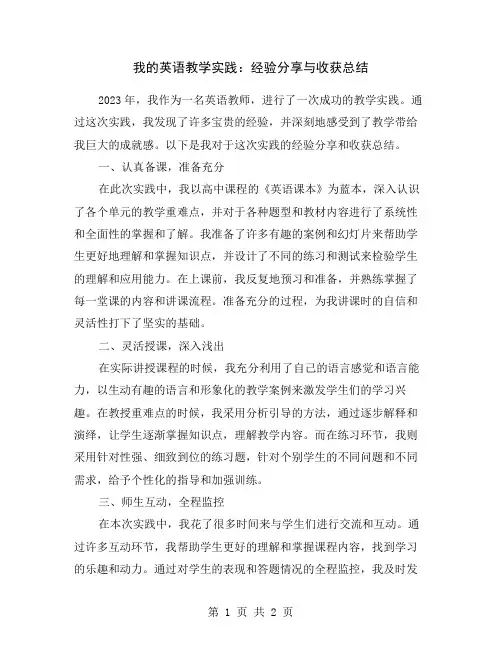
我的英语教学实践:经验分享与收获总结2023年,我作为一名英语教师,进行了一次成功的教学实践。
通过这次实践,我发现了许多宝贵的经验,并深刻地感受到了教学带给我巨大的成就感。
以下是我对于这次实践的经验分享和收获总结。
一、认真备课,准备充分在此次实践中,我以高中课程的《英语课本》为蓝本,深入认识了各个单元的教学重难点,并对于各种题型和教材内容进行了系统性和全面性的掌握和了解。
我准备了许多有趣的案例和幻灯片来帮助学生更好地理解和掌握知识点,并设计了不同的练习和测试来检验学生的理解和应用能力。
在上课前,我反复地预习和准备,并熟练掌握了每一堂课的内容和讲课流程。
准备充分的过程,为我讲课时的自信和灵活性打下了坚实的基础。
二、灵活授课,深入浅出在实际讲授课程的时候,我充分利用了自己的语言感觉和语言能力,以生动有趣的语言和形象化的教学案例来激发学生们的学习兴趣。
在教授重难点的时候,我采用分析引导的方法,通过逐步解释和演绎,让学生逐渐掌握知识点,理解教学内容。
而在练习环节,我则采用针对性强、细致到位的练习题,针对个别学生的不同问题和不同需求,给予个性化的指导和加强训练。
三、师生互动,全程监控在本次实践中,我花了很多时间来与学生们进行交流和互动。
通过许多互动环节,我帮助学生更好的理解和掌握课程内容,找到学习的乐趣和动力。
通过对学生的表现和答题情况的全程监控,我及时发现和解决了他们在学习过程中的各种问题和困惑。
同时,我及时收集学生学习情况和反馈建议,以便进一步改进和完善自己的教学方式和方法。
总之,在这次实践中,我非常珍惜和感恩学生们的支持和信任,同时也给予了他们最大的帮助和支持。
通过自己的不断努力和精心设计,在学生们学习上取得了优异的成绩。
同时,自己也深刻地体会到了教学带来的成就感和满足感,明白了自己作为一名优秀教师的责任和使命。
希望自己能够不断精益求精、不断努力提升自己的教学方式和教学水平,为学生们的学习道路上添砖加瓦。
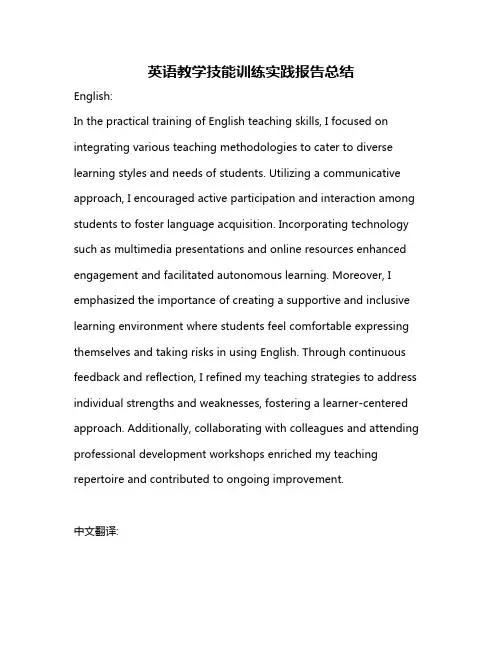
英语教学技能训练实践报告总结English:In the practical training of English teaching skills, I focused on integrating various teaching methodologies to cater to diverse learning styles and needs of students. Utilizing a communicative approach, I encouraged active participation and interaction among students to foster language acquisition. Incorporating technology such as multimedia presentations and online resources enhanced engagement and facilitated autonomous learning. Moreover, I emphasized the importance of creating a supportive and inclusive learning environment where students feel comfortable expressing themselves and taking risks in using English. Through continuous feedback and reflection, I refined my teaching strategies to address individual strengths and weaknesses, fostering a learner-centered approach. Additionally, collaborating with colleagues and attending professional development workshops enriched my teaching repertoire and contributed to ongoing improvement.中文翻译:在英语教学技能的实践训练中,我着重于整合各种教学方法,以满足学生多样化的学习风格和需求。
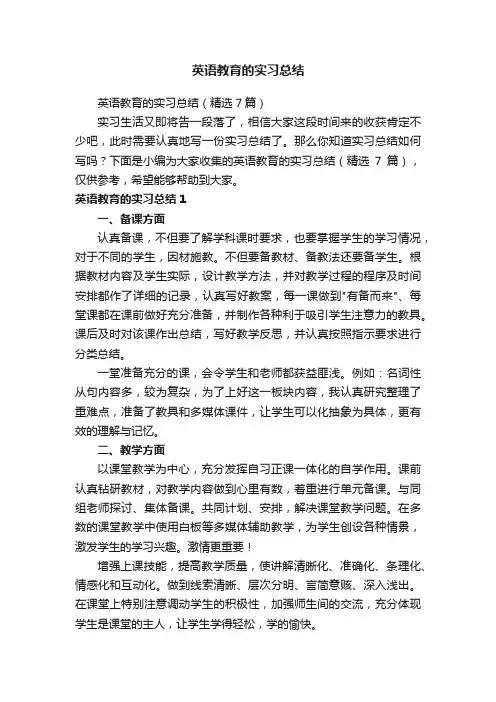
英语教育的实习总结英语教育的实习总结(精选7篇)实习生活又即将告一段落了,相信大家这段时间来的收获肯定不少吧,此时需要认真地写一份实习总结了。
那么你知道实习总结如何写吗?下面是小编为大家收集的英语教育的实习总结(精选7篇),仅供参考,希望能够帮助到大家。
英语教育的实习总结1一、备课方面认真备课,不但要了解学科课时要求,也要掌握学生的学习情况,对于不同的学生,因材施教。
不但要备教材、备教法还要备学生。
根据教材内容及学生实际,设计教学方法,并对教学过程的程序及时间安排都作了详细的记录,认真写好教案,每一课做到"有备而来"、每堂课都在课前做好充分准备,并制作各种利于吸引学生注意力的教具。
课后及时对该课作出总结,写好教学反思,并认真按照指示要求进行分类总结。
一堂准备充分的课,会令学生和老师都获益匪浅。
例如:名词性从句内容多,较为复杂,为了上好这一板块内容,我认真研究整理了重难点,准备了教具和多媒体课件,让学生可以化抽象为具体,更有效的理解与记忆。
二、教学方面以课堂教学为中心,充分发挥自习正课一体化的自学作用。
课前认真钻研教材,对教学内容做到心里有数,着重进行单元备课。
与同组老师探讨、集体备课。
共同计划、安排,解决课堂教学问题。
在多数的课堂教学中使用白板等多媒体辅助教学,为学生创设各种情景,激发学生的学习兴趣。
激情更重要!增强上课技能,提高教学质量,使讲解清晰化、准确化、条理化、情感化和互动化。
做到线索清晰、层次分明、言简意赅、深入浅出。
在课堂上特别注意调动学生的积极性,加强师生间的交流,充分体现学生是课堂的主人,让学生学得轻松,学的愉快。
注意精讲精练,在课堂上,老师讲得尽量少,学生动口动手尽量多,同时在每一堂课上都能充分考虑每个层次学生的学习需求和学习能力,让每个层次的学生都得到提高。
三、培养学生学习习惯在培养学生学习习惯的过程中,首先鼓励学生养成独立完成作业的习惯,针对部分学生作为懒散,应付公事,我通过同桌和小组之间的完成情况,让他们形成竞争,不做学习的懒人,对激发学生的学习兴趣起到了很好的效果。
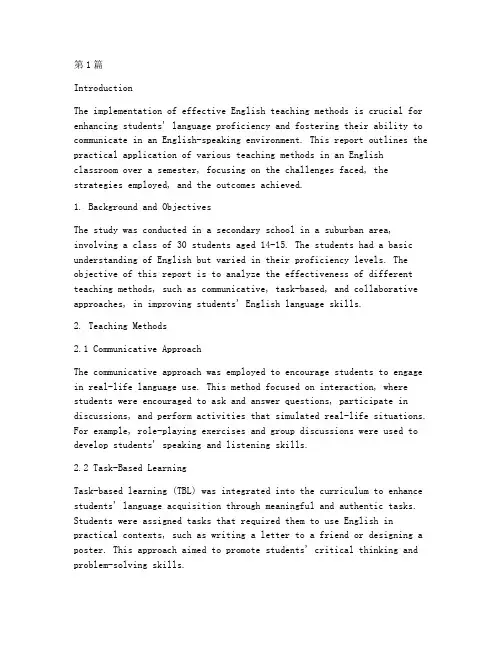
第1篇IntroductionThe implementation of effective English teaching methods is crucial for enhancing students' language proficiency and fostering their ability to communicate in an English-speaking environment. This report outlines the practical application of various teaching methods in an English classroom over a semester, focusing on the challenges faced, the strategies employed, and the outcomes achieved.1. Background and ObjectivesThe study was conducted in a secondary school in a suburban area, involving a class of 30 students aged 14-15. The students had a basic understanding of English but varied in their proficiency levels. The objective of this report is to analyze the effectiveness of different teaching methods, such as communicative, task-based, and collaborative approaches, in improving students' English language skills.2. Teaching Methods2.1 Communicative ApproachThe communicative approach was employed to encourage students to engage in real-life language use. This method focused on interaction, where students were encouraged to ask and answer questions, participate in discussions, and perform activities that simulated real-life situations. For example, role-playing exercises and group discussions were used to develop students' speaking and listening skills.2.2 Task-Based LearningTask-based learning (TBL) was integrated into the curriculum to enhance students' language acquisition through meaningful and authentic tasks. Students were assigned tasks that required them to use English in practical contexts, such as writing a letter to a friend or designing a poster. This approach aimed to promote students' critical thinking and problem-solving skills.2.3 Collaborative LearningCollaborative learning techniques were utilized to foster teamwork and cooperation among students. Pair work and group projects were regularly incorporated into the lessons, enabling students to share ideas, exchange knowledge, and support each other in achieving common goals. This method aimed to develop students' interpersonal and communication skills.3. Challenges and Strategies3.1 Student EngagementOne of the challenges faced was maintaining student engagement, especially with students who were less motivated. To address this, various strategies were employed, such as incorporating multimedia resources, using gamification techniques, and offering incentives for participation.3.2 Language Proficiency LevelsThe diverse language proficiency levels of the students presented a challenge in creating inclusive lessons. To tackle this, differentiated instruction was implemented, where tasks and activities were tailored to meet the needs of students at different proficiency levels.3.3 Time ManagementTime management was another challenge, as teachers had to balance the need for covering the curriculum with providing students with ample opportunities for practice. To optimize time, teachers planned lessons with clear objectives and structured activities, ensuring that each session was efficient and effective.4. Outcomes4.1 Student PerformanceThe implementation of the various teaching methods resulted in improved student performance. Students showed significant progress in theirspeaking, listening, reading, and writing skills. Their ability to communicate in English in real-life situations also improved.4.2 Teacher FeedbackTeacher feedback indicated that the teaching methods employed were effective in promoting student engagement and fostering a positive learning environment. Students were more motivated to participate in class activities and showed greater confidence in their English language abilities.4.3 Parental InvolvementParents reported positive changes in their children's English language skills, noting improvements in their ability to communicate and express themselves in English.5. ConclusionThe practical implementation of English teaching methods, such as the communicative approach, task-based learning, and collaborative learning, has proven to be effective in enhancing students' language proficiency and fostering their ability to communicate in an English-speaking environment. Despite the challenges faced, the outcomes achieved demonstrate the value of employing a diverse range of teachingstrategies in an English classroom.This report highlights the importance of tailoring teaching methods to meet the needs of diverse student populations and the significance of maintaining a positive and engaging learning environment. Further research and experimentation with different teaching methods are recommended to continue improving the effectiveness of English language instruction.References- Little, D. (2000). Theories and Principles of Language Teaching. Oxford University Press.- Richards, J. C., & Rodgers, T. S. (2001). Approaches and Methods in Language Teaching. Cambridge University Press.- Nunan, D. (1991). Language Teaching Methodology: A Textbook for Teachers. Prentice Hall.第2篇IntroductionThe implementation of effective English teaching methods is crucial in fostering a positive learning environment and enhancing students' language proficiency. This report details the practical application of various teaching methods in an English classroom over a semester. The focus is on the methods used, the outcomes observed, and the challenges faced during the implementation process.1. Introduction to the Classroom SettingThe classroom consisted of 30 students, aged 14-16, with varying levels of English proficiency. The majority of the students were beginners, with a few intermediate learners. The curriculum focused on basic grammar, vocabulary, reading, writing, listening, and speaking skills.2. Teaching Methods Used2.1. Communicative ApproachThe communicative approach was adopted to encourage interaction andreal-life language use. This involved group discussions, role-plays, and pair work activities. For example, students were asked to discuss their favorite hobbies and exchange information about their daily routines. This not only improved their speaking skills but also enhanced their listening comprehension.2.2. Task-Based LearningTask-based learning (TBL) was employed to engage students in authentic language tasks. Tasks included writing short essays, creating posters, and presenting projects on various topics. This approach helped studentsdevelop their critical thinking and problem-solving skills while improving their writing and speaking abilities.2.3. Multimedia IntegrationThe use of multimedia resources, such as videos, podcasts, and online articles, was incorporated into the teaching process. For instance, students watched short videos related to the topic of the lesson and discussed the content in class. This method made the learning experience more dynamic and engaging.2.4. Flipped ClassroomA flipped classroom model was implemented to promote student autonomy. Students were assigned pre-class tasks, such as watching educational videos or reading articles, and were expected to come to class prepared to discuss the content. This approach freed up class time for more interactive activities and allowed students to learn at their own pace.3. Outcomes Observed3.1. Increased ParticipationThe implementation of various teaching methods led to increased student participation. Students were more engaged in class activities, and their enthusiasm for learning English grew. This was evident in the improved attendance rates and the positive feedback received from students.3.2. Enhanced Language ProficiencyStudents' language proficiency improved significantly. The communicative approach helped them develop their speaking and listening skills, while the task-based learning and flipped classroom model enhanced their writing and reading abilities. This was reflected in their performance on quizzes, tests, and projects.3.3. Improved Critical ThinkingThe use of TBL and multimedia resources encouraged students to think critically and analyze information. They were able to apply their knowledge to real-life situations and solve problems independently.4. Challenges Faced4.1. Classroom ManagementManaging a diverse classroom with varying levels of proficiency was challenging. Some students found the activities too easy, while others struggled to keep up. To address this, differentiated instruction was implemented, allowing students to work at their own pace.4.2. Time ConstraintsIntegrating various teaching methods and resources into the curriculum was time-consuming. However, the use of technology and pre-class assignments helped to optimize the use of class time.4.3. Parental InvolvementLimited parental involvement made it difficult to track students' progress outside the classroom. To overcome this, regular progress reports were sent home, and parents were encouraged to communicate with the teacher.5. ConclusionThe implementation of various English teaching methods in the classroom resulted in a positive learning environment and significant improvements in students' language proficiency. The communicative approach, task-based learning, multimedia integration, and flipped classroom model were effective in engaging students and fostering their language skills. Despite the challenges faced, the overall outcome was positive, and the students' progress was evident. Future efforts should focus on further enhancing classroom management, parental involvement, and theintegration of technology in the teaching process.第3篇IntroductionThe implementation of effective teaching methods is crucial for enhancing the learning experience of students in English language education. This report outlines the practical application of variousteaching methods in an English classroom setting. The report is based on a semester-long experiment conducted in a secondary school in China, where a diverse group of students from different linguistic backgrounds were taught English. The report will discuss the methods used, the challenges encountered, and the outcomes observed.1. Introduction to the Teaching MethodsFor this experiment, a combination of traditional and innovative teaching methods was employed. The following methods were primarily utilized:1.1. Direct MethodThe direct method, also known as the audio-lingual method, emphasizes the use of the target language in the classroom. This method involves the use of textbooks, audio recordings, and interactive activities to promote language acquisition.1.2. Communicative Language Teaching (CLT)CLT focuses on communication as the primary goal of language learning. This method encourages students to engage in real-life conversations and tasks, thereby enhancing their speaking and listening skills.1.3. Task-Based Language Teaching (TBLT)TBLT involves the use of tasks that require students to use the target language in meaningful contexts. This method promotes language learning through authentic, real-life activities.1.4. Technology-Enhanced Language Learning (TELL)TELL integrates technology into the language learning process. This method utilizes multimedia resources, online platforms, and digitaltools to facilitate language learning.2. Implementation of Teaching Methods2.1. Direct MethodIn the initial stages of the experiment, the direct method was employed to introduce new vocabulary and grammar structures. Textbooks and audio recordings were used to ensure that students were exposed to the target language. Interactive activities, such as role-playing and pair work, were also incorporated to reinforce the learning.2.2. Communicative Language Teaching (CLT)To foster communication skills, students were encouraged to participate in group discussions, debates, and role-plays. Real-life scenarios were created to make the language learning experience more engaging and relevant.2.3. Task-Based Language Teaching (TBLT)Students were assigned various tasks, such as writing essays, creating presentations, and conducting interviews. These tasks were designed to challenge students to use the target language in different contexts.2.4. Technology-Enhanced Language Learning (TELL)The integration of technology into the classroom was achieved through the use of educational software, online dictionaries, and interactive whiteboards. Students were also encouraged to utilize online resources for self-study.3. Challenges Encountered3.1. Student DiversityThe diverse linguistic backgrounds of the students presented a challenge in ensuring that the teaching methods were suitable for all. Adaptations had to be made to cater to the varying levels of proficiency.3.2. Time ConstraintsThe limited time available for each lesson made it difficult to coverall the teaching methods thoroughly. Prioritization and efficient time management were crucial in this aspect.3.3. Teacher CompetenceThe effectiveness of the teaching methods relied heavily on theteacher's ability to adapt and implement them appropriately. Continuous professional development was necessary to ensure the best outcomes.4. Outcomes Observed4.1. Improved Language SkillsStudents showed significant improvement in their speaking, listening, reading, and writing skills. This was evident in their increased confidence and ability to use the target language in various contexts.4.2. Enhanced EngagementThe use of a variety of teaching methods helped to keep students engaged and interested in the learning process. This was reflected in their higher participation rates and positive feedback.4.3. Increased AutonomyStudents developed a sense of autonomy in their language learning journey. They were able to utilize online resources and apply the teaching methods independently.5. ConclusionThe practical application of various teaching methods in the English classroom setting proved to be beneficial for both students and teachers. The combination of traditional and innovative methods provided a comprehensive approach to language learning. While challenges were encountered, the positive outcomes observed highlighted the importanceof adapting teaching methods to suit the needs of diverse learners. This experiment serves as a valuable reference for future English language educators in implementing effective teaching strategies.References- Little, D. (2004). Theories and Methods in Language Teaching. Oxford University Press.- Richards, J. C., & Rodgers, T. S. (2001). Approaches and Methods in Language Teaching. Cambridge University Press.- Warschauer, M. (2000). Technology and Second Language Learning. Cambridge University Press.。
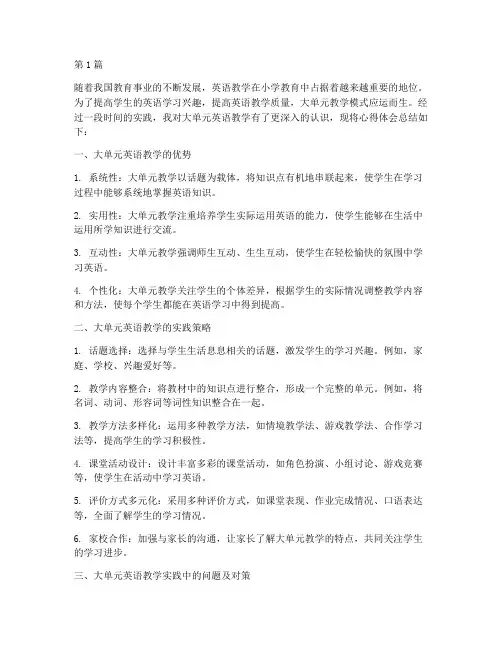
第1篇随着我国教育事业的不断发展,英语教学在小学教育中占据着越来越重要的地位。
为了提高学生的英语学习兴趣,提高英语教学质量,大单元教学模式应运而生。
经过一段时间的实践,我对大单元英语教学有了更深入的认识,现将心得体会总结如下:一、大单元英语教学的优势1. 系统性:大单元教学以话题为载体,将知识点有机地串联起来,使学生在学习过程中能够系统地掌握英语知识。
2. 实用性:大单元教学注重培养学生实际运用英语的能力,使学生能够在生活中运用所学知识进行交流。
3. 互动性:大单元教学强调师生互动、生生互动,使学生在轻松愉快的氛围中学习英语。
4. 个性化:大单元教学关注学生的个体差异,根据学生的实际情况调整教学内容和方法,使每个学生都能在英语学习中得到提高。
二、大单元英语教学的实践策略1. 话题选择:选择与学生生活息息相关的话题,激发学生的学习兴趣。
例如,家庭、学校、兴趣爱好等。
2. 教学内容整合:将教材中的知识点进行整合,形成一个完整的单元。
例如,将名词、动词、形容词等词性知识整合在一起。
3. 教学方法多样化:运用多种教学方法,如情境教学法、游戏教学法、合作学习法等,提高学生的学习积极性。
4. 课堂活动设计:设计丰富多彩的课堂活动,如角色扮演、小组讨论、游戏竞赛等,使学生在活动中学习英语。
5. 评价方式多元化:采用多种评价方式,如课堂表现、作业完成情况、口语表达等,全面了解学生的学习情况。
6. 家校合作:加强与家长的沟通,让家长了解大单元教学的特点,共同关注学生的学习进步。
三、大单元英语教学实践中的问题及对策1. 问题:部分学生对英语学习缺乏兴趣,导致课堂参与度不高。
对策:通过丰富多彩的教学活动,激发学生的学习兴趣。
同时,关注学生的个体差异,给予每个学生充分的关注和鼓励。
2. 问题:部分学生在课堂活动中表现不佳,影响整体教学效果。
对策:合理分组,让每个学生在小组活动中发挥自己的优势。
同时,教师应适时引导,帮助学生在活动中提高英语水平。
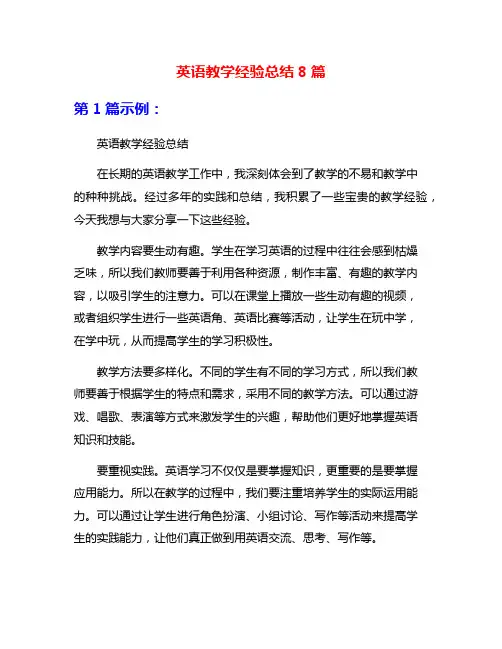
英语教学经验总结8篇第1篇示例:英语教学经验总结在长期的英语教学工作中,我深刻体会到了教学的不易和教学中的种种挑战。
经过多年的实践和总结,我积累了一些宝贵的教学经验,今天我想与大家分享一下这些经验。
教学内容要生动有趣。
学生在学习英语的过程中往往会感到枯燥乏味,所以我们教师要善于利用各种资源,制作丰富、有趣的教学内容,以吸引学生的注意力。
可以在课堂上播放一些生动有趣的视频,或者组织学生进行一些英语角、英语比赛等活动,让学生在玩中学,在学中玩,从而提高学生的学习积极性。
教学方法要多样化。
不同的学生有不同的学习方式,所以我们教师要善于根据学生的特点和需求,采用不同的教学方法。
可以通过游戏、唱歌、表演等方式来激发学生的兴趣,帮助他们更好地掌握英语知识和技能。
要重视实践。
英语学习不仅仅是要掌握知识,更重要的是要掌握应用能力。
所以在教学的过程中,我们要注重培养学生的实际运用能力。
可以通过让学生进行角色扮演、小组讨论、写作等活动来提高学生的实践能力,让他们真正做到用英语交流、思考、写作等。
要重视学生的情感体验。
学习是一种情感活动,只有学生在情感上投入了,才会更容易取得学习的成果。
所以我们教师要善于在教学中注重培养学生的情感体验,激发他们学习的热情。
可以通过教授一些精彩的英语文学作品、英语歌曲等来感染学生,让学生在情感上愿意去接受英语,愿意去学习英语。
要重视课外辅导。
课堂教学只是学生学习的一部分,更重要的是课外的辅导和帮助。
所以我们教师要善于在课外加强对学生的辅导和指导,帮助学生更好地巩固所学的知识,解决学习中的问题。
可以通过组织一些英语角、课外辅导班等方式,来给学生提供更多的学习机会。
英语教学是一项复杂而又有趣的工作,只有我们教师在实践中不断总结经验,不断完善自己的教学方法,才能更好地帮助学生学好英语。
希望我的这些经验总结能对大家有所帮助,也希望大家能够一起分享更多的教学经验,让我们共同进步。
【2000字】第2篇示例:英语教学是一项具有挑战性和乐趣的工作,我在多年的教学经验中积累了许多宝贵的经验。
英语教学实践心得总结与改进引言:近年来,随着中国对外交流的不断增加,英语语言学习已经成为了学生的必修课程。
英语教学也逐渐成为教育领域的热点。
然而,对于很多英语教师来说,教学实践是一种挑战。
在这篇文章中,我将总结我的英语教学实践心得,并探讨一些改进的方法。
一、了解学生需求和兴趣激发学生对英语学习的兴趣是有效教学的基础,所以了解学生的需求和兴趣非常重要。
一方面,可以通过问卷调查、观察等方式,了解学生的英语学习需求;另一方面,可以通过多种教学手段,如英语角、英文小组等,调动学生参与的热情。
二、创设情境,提供真实语言环境在教学实践中,创设情境是非常重要的。
通过创造真实的语言环境,学生可以更好地运用英语。
例如,可以组织角色扮演、情景模拟等活动,让学生在模拟真实情景中使用所学的英语知识和技能。
三、灵活运用教学方法与技巧灵活运用不同的教学方法与技巧,能够帮助学生更好地掌握英语知识。
例如,采用多媒体教学可以激发学生的学习兴趣;运用游戏化教学可以提高学生的参与度;利用配对活动可以激发学生的合作意识。
四、鼓励学生主动学习与交流英语学习是一种主动的过程,所以鼓励学生主动学习与交流非常重要。
可以通过安排小组讨论、开展作业交流等形式,激发学生参与学习的积极性。
五、培养学生自主学习能力自主学习是培养学生长期兴趣和有效学习的重要途径。
可以通过设计自主学习的任务,如报告、研究项目等,激发学生的主动学习能力。
六、关注学生的学习策略学习策略是帮助学生有效学习的重要手段。
教师可以关注学生的学习策略,发现学生的优点和不足,并提供相应的指导和帮助。
七、反思与改进教学实践教师需要不断反思自己的教学实践,找出不足之处并进行改进。
可以通过观察课堂、听取学生反馈、参加教研活动等方式,不断提高自己的教学水平。
结语:英语教学是一个复杂而又充满挑战的过程,教师在实践中需要不断总结经验,改进教学方法与技巧。
通过了解学生需求和兴趣,创设情境,灵活运用教学方法,鼓励学生主动学习与交流,培养学生自主学习能力,关注学生的学习策略,并不断反思与改进教学实践,我们可以更好地提高英语教学的效果,帮助学生更好地掌握英语语言技能。
英语教学实践心得6篇英语教学实践心得篇1在小学英语课堂教学中,首先教师不仅要懂得课堂教学规律,掌握一定的教育学、心理学知识,还必须关注每一位学生,运用一定的组织艺术,努力调动学生的有意注意,激发学生的情感,使学生在愉快、轻松的心境中全身心地投入到学习中去;其次,教师要将语言作为交流和描述的工具,把英语教学与各学科有机的整合,以此培养学生的综合能力。
英语作为一门新兴的综合性课程,走进了小学课堂,要学习它就如同幼儿学习母语一样,一切要从头开始。
在课堂上,应注意以下几个方面:(1)课堂尽量英语化。
尽量避免用母语进行教学,是进行外语课堂教学的原则之一。
语言是思维的工具。
为了使小学生的思维尽快地与英语联系起来,在英语课堂组织教学中要尽可能使用英语,做到课堂英语化,以排除对母语的依赖和母语的干扰。
小学阶段是学习英语的关键期之一。
尽管他们刚涉及英语,掌握的单词和句型甚少,但我们应该从第一节课起,坚持用英语组织教学。
由于这时所学一般都是词义具体的单词和简单句子,教师完全可以借助于直观手段来教,帮助学生尽快对内容的理解。
在课堂中教师可以充分运用眼神、手势、动作、表情等形式。
以此来培养学生直接理解、直接学习和直接应用英语的习惯,初步形成直接用英语的思维能力。
(2)教学做到情景化。
小学英语课堂教学必须尽最大限度地引起学生的学习兴趣,为学生提供足够的机会用英语进行活动,让学生感受到运用所学语言成功地达到某种目的后的愉快。
这是小学生的年龄特点和英语学科的特殊性所决定的。
要使小学生能够在40分钟的时间内保持良好的学习状态,教师必须根据不同的教学内容创设各种情景,做到教学情景化。
首先,坚持用英语组织教学活动,教师应有计划地向学生传授课堂用语和日常用语,如:“who’sondutytoday?”“goodmorning/afternoon。
”“howareyou?i’mfine,thanks。
andyou?”。
建立如几人一组的“pairwork/groupwork。
第1篇一、引言随着我国教育改革的不断深入,高中英语教学也面临着新的挑战和机遇。
为了提高学生的英语水平,培养他们的跨文化交际能力,我们学校英语教研组积极开展了一系列的教学实践探索。
本文将总结近年来高中英语教学实践中的成果,以期为进一步提高教学质量提供参考。
二、教学实践成果1. 课程改革与创新(1)优化课程设置:根据新课程标准,我们调整了课程内容,增加了听说读写四项技能的培养比重,并引入了文化知识、跨文化交际等内容,使课程设置更加合理。
(2)创新教学模式:我们尝试了多种教学模式,如任务型教学、合作学习、翻转课堂等,以提高学生的学习兴趣和参与度。
(3)开发校本课程:针对我校学生的实际情况,我们开发了多门校本课程,如英语口语角、英语电影欣赏、英语角等,为学生提供了丰富的学习资源。
2. 教学方法与策略(1)注重学生主体地位:在教学过程中,我们充分尊重学生的主体地位,鼓励他们积极参与课堂活动,培养他们的自主学习能力。
(2)强化听说能力训练:通过角色扮演、小组讨论、演讲比赛等形式,提高学生的听说能力。
(3)注重阅读教学:引导学生进行广泛阅读,提高他们的阅读速度和理解能力,同时培养学生的阅读兴趣。
(4)运用多媒体技术:利用多媒体课件、网络资源等,丰富教学内容,提高教学效果。
3. 教学评价与反思(1)多元化评价:我们采用形成性评价和终结性评价相结合的方式,全面评估学生的学习成果。
(2)反思教学实践:定期进行教学反思,总结经验教训,不断改进教学方法。
4. 学生英语水平提高(1)成绩提升:通过一系列的教学改革和实践,学生的英语成绩普遍提高,尤其是听说能力。
(2)竞赛获奖:学生在各类英语竞赛中取得了优异成绩,展现了良好的英语素养。
三、案例分享案例一:任务型教学在英语课堂中的应用在教学《My First Day at High School》一课时,我们采用了任务型教学。
首先,让学生通过阅读课文,了解高中生活的基本情况。
第1篇一、教学背景随着新课程改革的不断深入,英语实践活动课在我国中小学教育中扮演着越来越重要的角色。
实践活动课旨在培养学生的英语实际运用能力,提高学生的综合素质。
本人在此基础上,结合教学实践,对英语实践活动课进行了一次教学反思。
二、教学过程1. 教学内容本次英语实践活动课的内容是关于“英语节日庆祝活动”。
通过让学生了解各个国家的节日,提高学生的跨文化交际能力,同时培养学生的团队合作精神。
2. 教学方法(1)任务型教学法:通过设计一系列任务,让学生在完成任务的过程中,提高英语实际运用能力。
(2)合作学习法:将学生分成若干小组,让他们在小组内讨论、合作,共同完成任务。
(3)情景教学法:通过创设真实的语言环境,让学生在实际情境中运用英语。
3. 教学环节(1)导入:通过图片、视频等形式,让学生了解各个国家的节日,激发学生的学习兴趣。
(2)任务分配:将学生分成若干小组,每个小组负责一个国家的节日。
要求小组成员共同收集资料、整理信息,制作出关于该国家节日的PPT。
(3)小组讨论:各小组进行讨论,分享各自制作的PPT,互相学习、借鉴。
(4)成果展示:各小组进行成果展示,其他小组成员进行评价,提出改进意见。
(5)总结:教师对本次活动进行总结,强调英语实践活动课的重要性,鼓励学生在日常生活中多运用英语。
三、教学反思1. 教学效果本次英语实践活动课取得了较好的效果。
学生在完成任务的过程中,不仅提高了英语实际运用能力,还培养了团队合作精神。
同时,学生们对各个国家的节日有了更深入的了解,拓宽了视野。
2. 教学亮点(1)任务型教学法:通过任务型教学法,让学生在完成任务的过程中,主动学习,提高英语实际运用能力。
(2)合作学习法:通过小组合作,培养学生的团队合作精神,提高学生的沟通能力。
(3)情景教学法:通过创设真实的语言环境,让学生在实际情境中运用英语,提高学生的口语表达能力。
3. 教学不足(1)课堂时间分配不合理:在课堂讨论环节,部分小组耗时较长,导致其他小组的展示时间较短。
英语教师实习工作小结范文8篇篇1时光荏苒,如白驹过隙,转眼间,我在英语教师实习岗位上已经工作了三个多月。
这段时间里,我经历了从初入职场的新手到逐渐适应工作节奏的转变,也深刻体会到了教育工作的意义和责任。
现在,我将对自己在实习期间的工作进行一个小结,以期为未来的教育工作提供借鉴和反思。
一、教学工作方面在实习期间,我主要负责初中阶段的英语教学工作。
由于学生英语基础参差不齐,我始终坚持因材施教的教学原则,针对不同层次的学生制定不同的教学计划和方法。
通过备课、上课、辅导等环节,我努力提高自己的教学水平,同时也取得了不错的教学效果。
在课程设计方面,我注重培养学生的听、说、读、写能力,通过丰富多样的教学活动和任务设计,激发学生的学习兴趣和积极性。
例如,我组织了英语角活动,让学生有机会在实践中运用英语;我还设计了英语日记写作任务,提高学生的英语写作水平。
二、班级管理方面作为英语教师,我不仅关注学生的学科学习,还积极参与班级管理工作。
我通过与学生的交流和互动,了解他们的学习和生活情况,及时发现问题并给予帮助和指导。
同时,我还与家长保持密切联系,共同关注孩子的成长和发展。
在班级管理过程中,我注重培养学生的自律能力和团队合作精神。
通过制定班级规则和建立奖惩机制,我帮助学生养成良好的学习和生活习惯。
此外,我还组织学生参加各种集体活动,如运动会、文艺汇演等,增强班级凝聚力。
三、自我提升方面在实习期间,我深知自己还有很多不足之处需要改进和提高。
因此,我始终保持学习的心态,不断学习和探索新的教学方法和理念。
我通过阅读相关书籍、观看教学视频以及参加教育培训等方式,不断提升自己的专业素养和教学能力。
同时,我还积极与同事和同行进行交流和讨论,分享彼此的教学经验和心得体会。
在这个过程中,我不仅获得了宝贵的经验和方法,还拓宽了视野和思路。
四、反思与总结回顾过去的实习经历,我认为自己在英语教学和班级管理方面取得了一定的成绩和经验。
但同时,我也意识到自己还存在一些不足之处需要改进和提高。
英语专业教育实习总结5篇篇1一、实习背景与目的本次实习旨在将英语专业所学知识与实践相结合,提升实际教学能力,掌握教育教学的规律与特点。
通过实习,以期达到对英语专业教育教学有更深入的理解,并为未来的教育工作打下坚实基础。
二、实习单位与岗位本次实习单位为一所知名中学,担任英语教育实习生。
实习期间,主要参与英语教育教学工作,包括课堂教学、备课、学生辅导及教研活动。
三、实习内容1. 课堂教学在实习期间,我参与了多个班级的英语教学工作。
通过实际授课,我发现了学生在英语学习上的难点与痛点,并尝试采用多种教学方法以激发学生的学习兴趣。
同时,我也关注到了不同学生的学习特点,尽量做到因材施教。
2. 备课工作备课是教学的重要环节。
在指导老师的帮助下,我逐渐掌握了备课的基本技巧。
我学会了如何分析教材、制定教学目标、设计教学流程等。
同时,我也积极参与团队备课,与同事们共同探讨教学方法与策略。
3. 学生辅导在实习期间,我还承担了一部分学生的辅导工作。
通过与学生的沟通与交流,我了解到学生在学习上存在的问题,并提供相应的指导与帮助。
同时,我也关注学生的心理状况,帮助他们树立学习信心。
4. 教研活动我积极参与学校的教研活动,听取其他教师的经验分享,并与其他教师探讨教育教学问题。
通过参与教研活动,我不断吸收新的教学理念与方法,提高自己的教学水平。
四、实习收获1. 教学能力的提高通过实际授课,我逐渐熟悉了教学流程,并提高了自己的教学能力。
在指导老师的帮助下,我学会了如何关注学生的需求,采用多种教学方法激发学生的学习兴趣。
2. 对教育教学的理解加深通过实习,我对教育教学有了更深入的理解。
我认识到,教育不仅仅是传授知识,更重要的是培养学生的能力与素质。
同时,我也关注到了不同学生的特点与需求,努力做到因材施教。
3. 教师职业素养的增强在实习过程中,我深刻体会到了教师的职业素养。
教师不仅要有扎实的专业知识,还要有良好的职业道德与敬业精神。
“英语教学法”实践课总结
“英语教学法”课程是英语专业本科(教育方向)的学生第三学期起开设的一门必选课。
该课程以教授基本的教学理论为切入点,最重要的是帮助学生将教学理论运用到实际教学活动中。
结合该课程的特点,在这门课程的教学过程中,我们每个学期都用课程总学时的30%组织实践课程。
本学期,实践课的安排尤其丰富。
1.到教育学院听专家讲座。
我们安排了两次教学方法的专家讲座,聘请了具备外国专家资格的加拿大教师Ken就如何更好地教授听力课
和口语课进行了两次讲座,从英语的本土语言者的角度把教学法的
具体运用和教学实践结合到一起,使同学们受益匪浅。
2.到实践基地进行实践。
本学期的实践活动安排在三个小学,分别是大连市试验小学,大连市五四路小学,大连市解放小学。
活动的具
体内容是由我校学生上公开课,同时由其他同学听课评课。
这类活
动实用性很强,对于正在当英语教师的学生而言是个交流的好机会,
对于从未当过老师的同学而言,更是起到了画龙点睛的作用。
这门课程的实践的实用意义之一还在于它也是学生进行毕业论文的选题指导之一。
英语专业的本科毕业论文是进行教学设计,在公开课上的一些想法和疑问正为学生的论文开题提供了思路,鼓励了他们的教学法研讨。
在这门课程未来的教学中,我们将更灵活,更多样地组织各类实践活动。